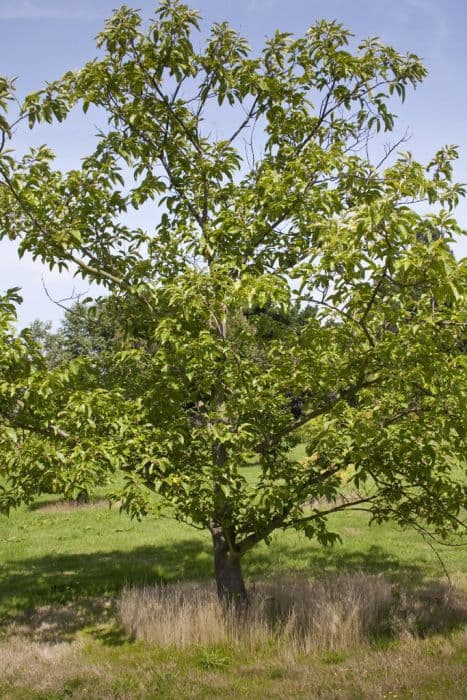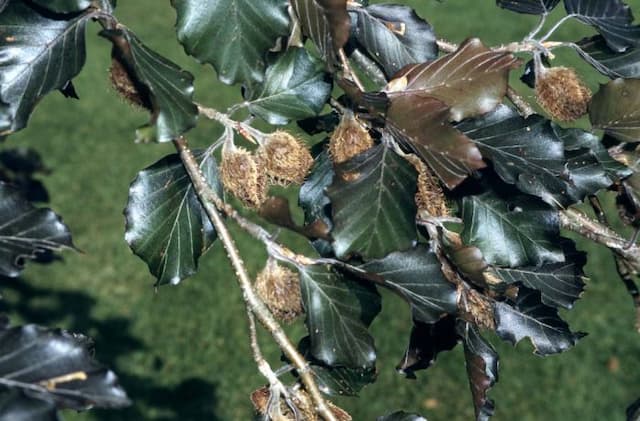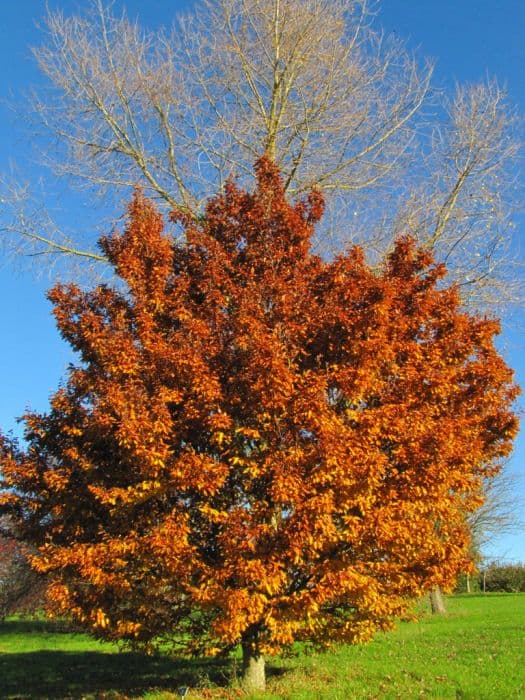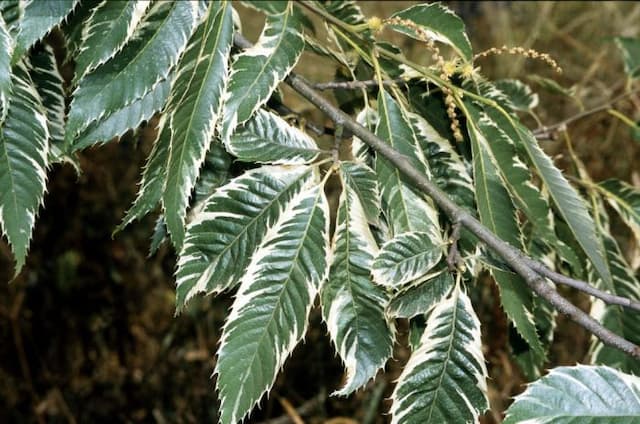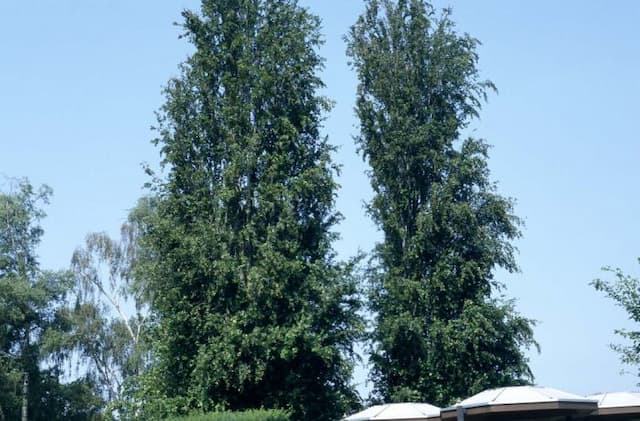Oak 'Lucombeana' Quercus × crenata 'Lucombeana'
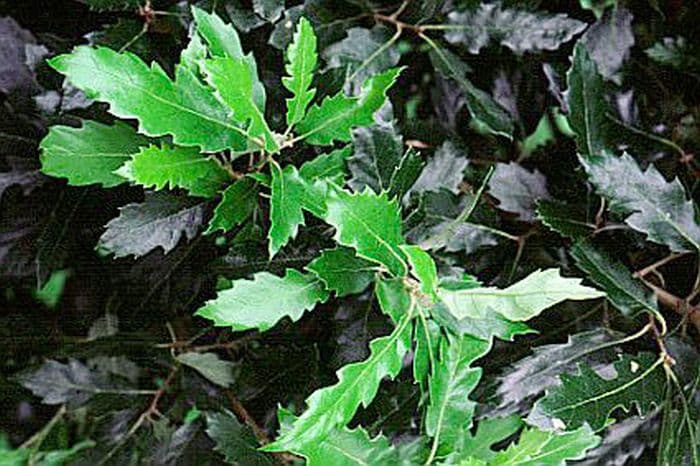
ABOUT
'Lucombeana' is a large semi-evergreen tree of statuesque habit, with shallowly-lobed, leathery oblong leaves, glossy above, greyish beneath, persisting well into winter
About this plant
 Names
NamesFamily
Fagaceae
Synonyms
Lucombe Oak, Lucombe's Oak
Common names
Quercus × lucombeana
 Characteristics
CharacteristicsLife cycle
Perennials
Foliage type
Evergreen
Color of leaves
Green
Height
20-40 feet (6-12 meters)
Spread
20-40 feet (6-12 meters)
Plant type
Tree
Hardiness zones
7
Native area
Hybrid
Benefits
 General Benefits
General Benefits- Shade provider: The tree offers a large canopy that can create a cool, shaded area, ideal for parks and large gardens.
- Aesthetic appeal: Its grand stature and evergreen leaves make it an attractive ornamental tree year-round.
- Habitat support: Serves as a habitat and food source for a variety of wildlife, including birds and insects.
- Soil stabilization: The extensive root system can help to prevent soil erosion, particularly on slopes.
- Longevity: Typically lives for many years, providing long-term benefits to the environment.
- Carbon sequestration: Like other trees, it captures atmospheric carbon dioxide, helping to mitigate climate change.
- Acoustic barrier: When planted in groups, it can act as a noise buffer, reducing sound pollution.
- Urban resilience: Tolerant of urban pollution and therefore suitable for city planting to enhance urban green spaces.
 Medical Properties
Medical PropertiesThis plant is not used for medical purposes.
 Air-purifying Qualities
Air-purifying QualitiesThis plant is not specifically known for air purifying qualities.
 Other Uses
Other Uses- The Lucombe Oak's wood is highly appreciated for fine woodworking and cabinetry, due to its durability and attractive grain.
- Its acorns can be utilized for crafting unique jewelry pieces, such as necklaces and earrings, after proper cleaning and preparation.
- The tree is occasionally planted in vineyards to provide beneficial shade and improve the microclimate for grape cultivation.
- Due to its strong wood, the Lucombe Oak has historically been used in the construction of shipbuilding, particularly for the framing and keel of ships.
- The tannin rich bark of the Lucombe Oak can be used in the leather tanning industry to treat hides and give them durability and color.
- In large estates or parks, these trees are used to create shelter belts or windbreaks, helping to protect more vulnerable plants and reduce soil erosion.
- The dense canopy of the Lucombe Oak offers habitat and nesting opportunities for various bird species, thus supporting local biodiversity.
- Its large size and robust nature make the Lucombe Oak a preferred choice as a statement or memorial tree in landscapes and gardens.
- The leaves can be used in compost as a brown material, providing a source of carbon that helps to break down nitrogen-rich green materials.
- The Lucombe Oak can serve as a natural dye source, offering tan or brown hues to fabrics when processed correctly.
Interesting Facts
 Feng Shui
Feng ShuiThe Lucombe Oak is not used in Feng Shui practice.
 Zodiac Sign Compitability
Zodiac Sign CompitabilityThe Lucombe Oak is not used in astrology practice.
 Plant Symbolism
Plant Symbolism- Strength and Endurance: As a hybrid oak (Quercus), Lucombe Oak represents strength and endurance, symbolizing the ability to withstand hardships and maintain stability over time.
- Wisdom: Traditionally, oaks are seen as ancient beings that symbolize wisdom and knowledge, as they live for hundreds of years and witness the passage of time.
- Heritage and Ancestry: The Lucombe Oak, like other oaks, may symbolize a connection to one's heritage and roots, reflecting the tree's long lifespan and its association with generations past.
- Nobility: In historical contexts, the oak is often associated with nobility, representing strength of character and the dignity of nature.
 Water
WaterThe Lucombe Oak should be watered deeply and infrequently to mimic its natural environment and encourage root development. Typically, the tree needs about 1.5 to 2.5 gallons of water every two weeks in the absence of rainfall. It is essential to adjust the watering frequency based on the season, with less water required during the winter dormancy period, and more during the hot summer months. Water should be applied slowly at the base of the tree to ensure deep soil penetration and to prevent runoff. It's crucial not to overwater, as this can lead to root rot, so always check the soil moisture before watering to make sure it is necessary.
 Light
LightFor optimal growth, the Lucombe Oak prefers full sunlight, which means it should be planted in a location where it can receive at least six hours of direct, unfiltered sunlight daily. Though it is adaptable and can tolerate partial shade, growth may be less vigorous and the tree might not develop as fully. The best spot for the Lucombe Oak is an open area, away from tall buildings or other structures that could block sunlight.
 Temperature
TemperatureThe Lucombe Oak thrives best in a moderate temperature range typical of temperate climates. It is resilient and able to withstand temperatures as low as 20°F and as high as 100°F, though it prefers to grow in conditions between 50°F and 80°F. Proper acclimatization is necessary for young trees when exposed to temperature extremes to reduce the chances of damage.
 Pruning
PruningPruning the Lucombe Oak is important for maintaining its structure, health, and aesthetic appeal. Ideally, pruning should be done during the dormant season, usually in late winter before new growth starts. This timing helps prevent disease entry and excessive sap loss. It's necessary to remove any dead, broken, or diseased branches and to thin the canopy if needed to let in light and air. Occasional pruning may also be done to shape the tree or control its size.
 Cleaning
CleaningAs needed
 Soil
SoilThe Lucombe Oak prefers well-draining soil with a pH between 5.5 and 7.5. A mix of loam, compost, and coarse sand or perlite is ideal for creating the right conditions. Ensuring adequate organic content will also help to mimic its natural growing environment.
 Repotting
RepottingLucombe Oaks, being large trees, are not typically repotted. Instead, they should be planted in a location where they can grow undisturbed. Should they start in containers, they can be repotted every 2-3 years or until they are established enough to be planted in the ground.
 Humidity & Misting
Humidity & MistingThe Lucombe Oak thrives in outdoor conditions where humidity is naturally regulated by the environment. It does not require any special humidity considerations outside of its natural habitat preferences.
 Suitable locations
Suitable locationsIndoor
Not suitable for indoor growth, requires outdoor space to thrive.
Outdoor
Plant in well-draining soil, full sun to partial shade, with adequate space for growth.
Hardiness zone
7-9 USDA
 Life cycle
Life cycleQuercus × crenata 'Lucombeana', also known as Lucombe Oak, begins its life cycle as an acorn which, when conditions are right, germinates and sends down a taproot while a shoot emerges above ground. The sapling stage follows, characterized by rapid vertical growth and the development of a branching structure and leaves capable of photosynthesis. As the tree matures into its adult phase, it develops a broad canopy and robust trunk; this is when it becomes reproductive, producing catkins which are wind-pollinated, leading to the production of acorns. After decades, or even centuries, the Lucombe Oak enters a period of senescence where growth slows, and it may be more susceptible to pests, diseases, and environmental stresses. The final stage is the death of the tree, which can occur due to a variety of factors such as extreme weather, infections, or old age; once dead, the tree decomposes, returning nutrients to the ecosystem and potentially providing habitat for wildlife even as it breaks down. Throughout its life cycle, the Lucombe Oak serves as an important source of food and habitat for various animals, from insects to birds and mammals.
 Propogation
PropogationPropogation time
Spring-Early Summer
The most common method of propagation for the Lucombe oak, which is a hybrid between the Turkey oak and the Cork oak, is by grafting. Grafting involves joining the tissues of plants so that they can grow together. This technique is usually carried out in late winter or early spring. A piece of a stem with leaf buds, known as a scion, is taken from a desirable parent tree and then joined to a section of a rooted stem, called the rootstock, from another oak species that is grown for its hardiness and vigor. The scion and the rootstock are carefully cut at complementary angles, bound together, and sealed to prevent drying out. The grafted section is then kept in a humidity-controlled environment to encourage the scion and rootstock to fuse. After a successful graft, the tree inherits the characteristics of the Lucombe oak, such as its foliage, along with the rootstock's resilience and adaptability.
